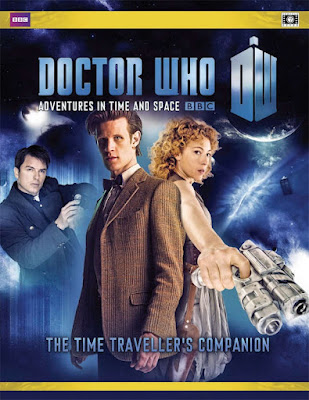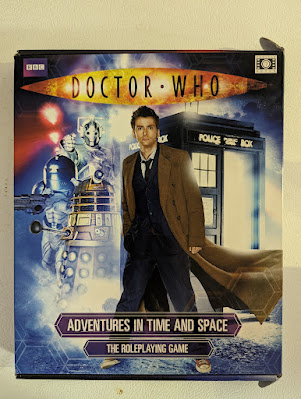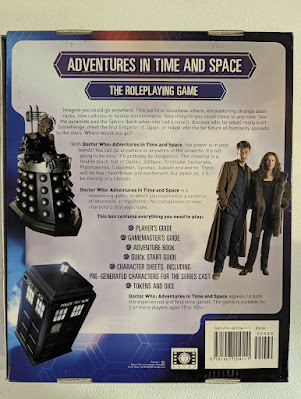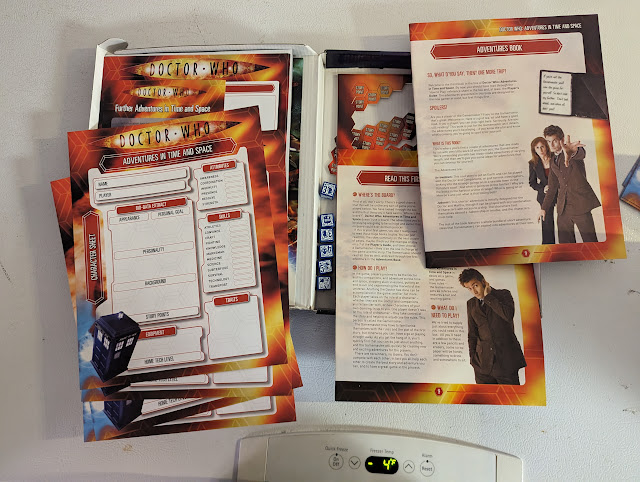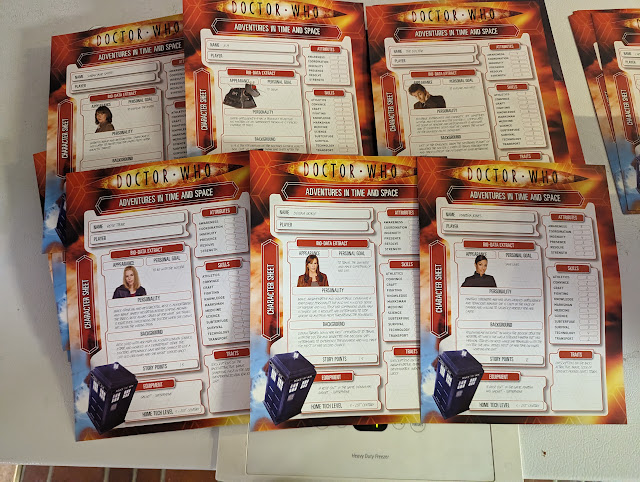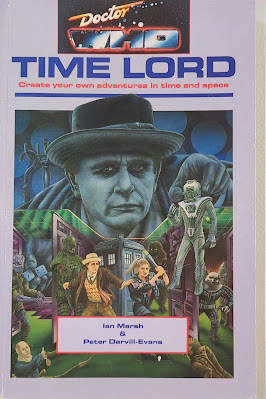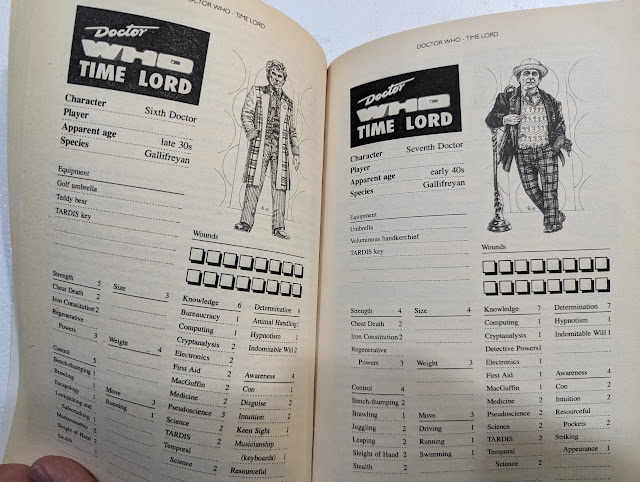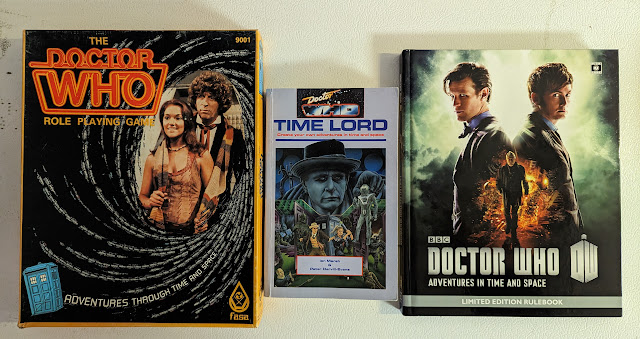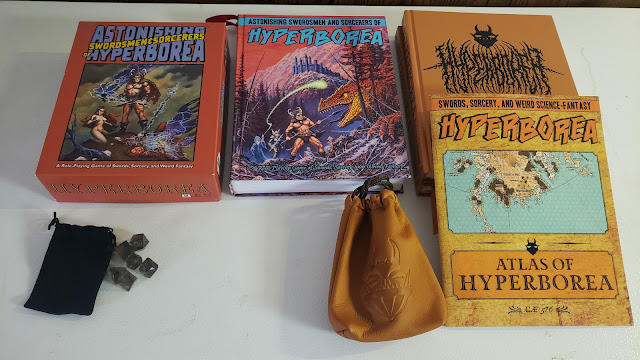A few quick ones now. I grabbed these to review because I wanted some of the Cubicle 7 books I knew would be good in emulating a FASA Doctor Who like game. So more UNIT, more CIA (Celestial Intervention Agency), and more aliens.
In all cases here I am reviewing the PDFs
Doctor Who: Aliens and CreaturesSix PDFs in one ZIP file. 220+ pages total.
From the 10th Doctor era. What grabbed me first about this book was how well it looks with other Doctor Who books from other sources. This is due to the BBC mandated trade dress. While it means every era of Doctor Who will give us a different look (and core book) it also means that the books my kids were buying at school book fairs (wow, that was a long time ago!) will look great on the shelves next the RPG books.
This package includes:
- 138 page rulebook detailing many of the creatures faced in the Doctor's adventures, including the Cybermen, Cult of Skaro, Davros, the Weeping Angels and the Hath, additional rules for creating your own creatures both as enemies or as playable characters, and a system for creating new worlds for your adventures to take place on
- 32 page Adventure book, featuring a whole new ready-to-play adventure and many ideas for additional stories
- New gadget cards
- Additional Story Point Counters
- Detailed Creature Cards for easy reference
All to work with your 10th Doctor boxed set. The same level of art, design and layout given to the core game is here, making it one of the more attractive games out these days. Perfect for the Doctor Who gamer and the Doctor Who fan alike. And an excellent source of new things to run away from!
This is a great product, full of all sorts of monsters, aliens, and other creatures primarily from the new version of Doctor Who (but some old favorites are still there). It was nice to have writeups for various Daleks, Cybermen, Catkind, Sontarans, and more. There are even more Traits and pre-built Trait packages given to aliens. Along with aliens come their worlds, we have more detail on these as well. So you don't have to stick to Earth!
The adventure book (32 pages) has two ready-to-go adventures using these new creatures; and plenty of ideas on how to use the others.
Some printing will be required for the cards and story point counters, but that is minimal.
Despite the "trade dress" this can be used with any version of the Doctor Who RPG from Cubicle 7.
Defending the Earth: The UNIT SourcebookPDF. 160 pages.
This book comes to us from the Matt Smith/11th Doctor era but it has call back to the 3rd, 4th, 7th, 10th, and more Doctors. Even the cover features UNIT officers from those periods.
Like all the Who books, this one is full color. While it skews more to the new Who series, there is a lot of Classic Who material here including stats for the 3rd Doctor (Jon Pertwee).
The UNIT (United Intelligence Taskforce) is tasked by the UN with protecting the Earth from Alien threats. This book allows you to create UNIT bases, and personal and comes with two sample adventures.
In many ways, a UNIT-based game can be more interesting than a Doctor-based one. In this, everyone can have a nicely defined role. You have field scientists, soldiers of all sorts, and even civilians.
Among the features of this book are the expanded firearms and mass combat rules. The History of UNIT. Personnel includes plenty of new traits for the military, science, and civilians. And two UNIT-based adventures.
This is one of my favorite sourcebooks for DW so far. Not just because of the limitless possibilities, but also because there is more attention paid to the older series than other books (note I am not saying this is a flaw of the other books, but it is a nice feature of this one).
I also see this as one of the more flexible books. You can set up a small UNIT command base and let the wackiness ensue. In fact, my own playtest adventures with DW could easily be converted into a UNIT game. Think back to the 3rd Doctor's adventures; these were mostly Earth based with UNIT. All of those are great ideas for a game. Or even the Sarah Jane Adventures.
As with all books in this line, it is full color, well laid out, and full of stills from the show.
Doctor Who - The Time Traveller's CompanionPDF 242 pages.
Again from the Matt Smtih/11th Doctor Era.
Now here is a book we would have LOVED to have had back in the FASA Doctor Who era. Everything we know about Gallifrey to date (well...to the date of this publication).
This product, like other supplements, is a bit freer with its use of material and image from the Classic series. So while the "trade dress" is the 11th Doctor, all the Doctors are featured here.
This book covers Gallifrey. It's history, it's culture, and of course, the Time Lords. This history by the way is great. We get deep cuts like "The Dark Times" and Morbius. Though only brief mentions of the Racnoss, the Great Vampires and the Carrionites in the Time Lord history. Interesting aside. All these early enemies of the Time Lords; spiders, vampires and witches respectively, all feature into the fears and horror tales of humans. Coincidence?
There is even a little bit on the Time War here.
Essentially if there is a Doctor Episode that featured Gallifrey or Time Lords it has representation here.
We get updates/expansions on Time Lord Character creation. This includes character creation based on which of the great academies the Time Lord comes from. Nice touch. There are even expanded regeneration rules here that predict how the War Doctor would be.
A brief overview of Time Travel is next. We get a good (ok better) explanations of the Blinovich Limitation Effect, or, "Why You Can't Cross Your Own Time Stream" and the Time Differential. Though the time differential is a good way to help explain how the Doctor never really knows how old he is.
There is coverage on Vortex Manipulators, Time Corridors, Time Scoops, Time Dams, even "primitive" time travel machines.
Updated information on TARDISes, including how to build your own in the game. Here things like the "Symbiotic Nuclei " of the Two Doctors episode is explained in 11th-Doctor-era terms and ideas.
Several TARDIS templates are given from Ancient (Type 1 to 29) to Decommissioned (Type 30 to 59, The Doctor's TARDIS is Type 40), Modern (Type 60 - 89, used by The Rani and the main TARDISes of the Time War), and Advanced (Type 90+). Like Characters, TARDISes have attributes and traits.
Lastly, there is a Gamemaster section, divided into four chapters.
This covers not only running a game, but things the GM needs to know that the players should not. These are details like what tyrant the Great Rassilon was, how Omega survived, how Morbius escaped Time Lord justice, the War Chief, and the workings of the CIA.
There are the hidden files about the weapons of the Time War (the Moment had not been created in the show just yet) and other monstrosities.
We get some other Time Lord Renegades from the show, Drax, The Monk (separate now), the Rani, Romana, and even the new regeneration cycle of the Master.
More details on travelling in time and how to deal with players being...well, players in this.
There is even a TARDIS controls diagram that reminds me of the 1980s Doctor Who Technical Manual which also works as a TARDIS character sheet.
--
These books are not required but certainly ad a LOT to your Doctor Who games. If your goal is to build a game that is more akin to what we used to do with the old FASA Doctor Who games, then these are the best places to start.



